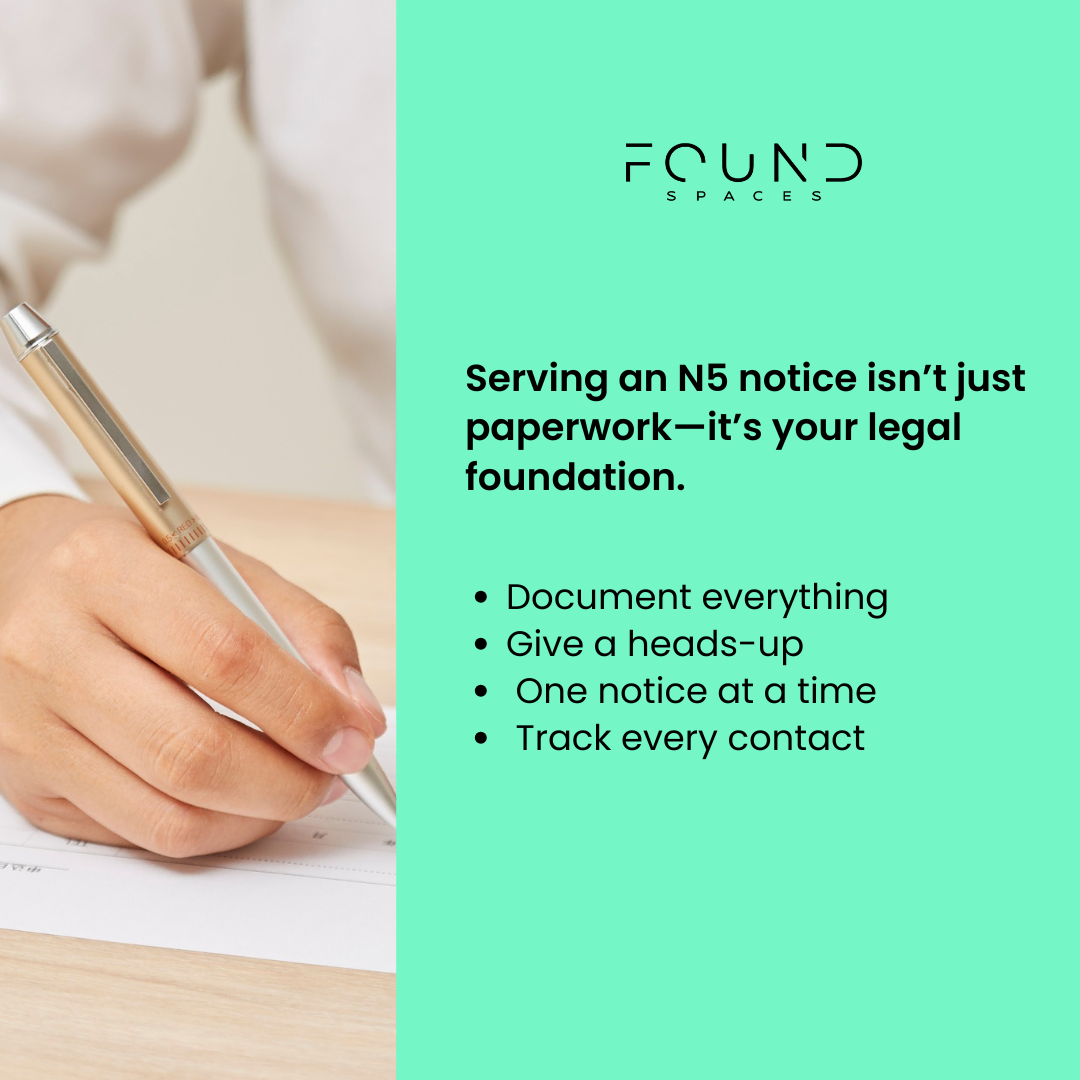As a landlord in Ontario, using the N5 form LTB is an important step to handle tenant damages or rule violations legally. The N5, issued through the Landlord and Tenant Board, notifies tenants about issues like property damage, noise disturbances, or unauthorized guests.
You should serve it quickly, within 7 days of noticing the problem, and include clear details and evidence. After serving, tenants have 7 days to fix the issue; if they don’t, you can apply to end the tenancy legally. Filling out and delivering this form correctly helps protect your rights while keeping everything fair and documented throughout the process.
What the N5 Form Is and When to Use It
The N5 form, officially called the Notice to End your Tenancy for Interfering with Others, Damage or Overcrowding, is a legal notice used by landlords in Ontario to address serious tenant breaches. It applies to issues like loud noise, smoking in restricted areas, property damage, unauthorized pets, or guests who interfere with others or harm the rental property.
This form allows landlords to formally document a problem and give the tenant a chance to correct it, usually within seven days. If the tenant addresses the issue within that time, the tenancy continues. If not, the landlord can move forward with the legal process through the Landlord and Tenant Board (LTB), including filing for eviction.
The N5 form should only be used when a tenant’s behavior causes significant disruption or real damage. It’s a structured legal tool designed to help landlords handle rule violations clearly and fairly.
Common Situations for Using the N5 Form
Ontario landlords often use the LTB N5 form to address specific tenant issues that affect property conditions or other residents’ quality of life. These include intentional or careless damage to the unit or shared spaces, such as broken fixtures or stained carpets caused by the tenant.
Repeated tenant disturbances, like loud parties or noise during quiet hours, also justify using the N5. Smoking violations, especially when smoking is prohibited under the lease or local bylaws, are another valid reason, as they can cause property damage or health complaints.
Unauthorized pets or animals that violate lease terms may pose a safety risk or disturb neighbors, and unauthorized guests can lead to overcrowding or security concerns. Harassment or threats toward neighbors or other residents are serious breaches that warrant formal notice. Even repeated violations of quiet enjoyment rules, after prior verbal or written warnings, can justify an N5.
Damage caused by visitors or contractors brought in by the tenant also qualifies, especially if it breaches lease conditions. More broadly, any misuse of the unit or common facilities, or any tenant behavior that threatens the safety, health, or peaceful enjoyment of others, can be addressed using the N5. For example, if a guest repeatedly leaves garbage in shared areas or creates hazards, the landlord may issue an N5 to notify the tenant and request corrective action before escalating.
| Common Situation | Description |
| Property Damage | Intentional or careless damage to the rental property or common areas. |
| Noise Disturbances | Repeated loud noise or disturbances affecting neighbors’ reasonable enjoyment. |
| Smoking Violation | Smoking inside the unit or in prohibited areas causing complaints or damage. |
| Unauthorized Pets | Unauthorized pets or animals violating the lease agreement. |
| Unauthorized Guests | Unauthorized guests causing overcrowding or security concerns. |
| Harassment or Threats | Harassment or threats by the tenant toward neighbors or other residents. |
| Repeated Quiet Enjoyment Breaches | Repeated breaches of quiet enjoyment rules despite prior warnings. |
| Damage by Visitors or Contractors | Damage caused by tenants’ visitors or contractors acting on their behalf. |
| Lease Misuse | Lease violations related to misuse of property or facilities. |
| Safety or Health Risks | Situations where tenant behavior risks safety, health, or peace of others. |
How to Fill Out the N5 Form Step by Step
At Found Spaces, we always recommend starting with the correct form from the official Landlord and Tenant Board website. Fill in all landlord and tenant contact details carefully to avoid delays.
When describing the issue, be detailed. Include exact dates, times, and specific events. Vague claims like “tenant caused trouble” are not enough. Clearly state what lease clause was violated and how. Attach supporting evidence like photos, written complaints, or witness statements. Found Spaces often helps clients gather and organize this material to ensure nothing is missed.
Be sure to give the tenant seven calendar days to fix the issue, as required by law. Before serving the notice, double-check all sections are complete and clearly worded. Use plain language to make sure the tenant understands the concern and what they need to do. Found Spaces also advises landlords to keep copies of the form and all related documents in case the matter escalates.
Proper Ways to Serve the N5 Form
How the N5 is served matters just as much as what’s on it. Found Spaces helps landlords follow the correct service methods to avoid legal setbacks. The best option is delivering it in person and handing it directly to the tenant, as this provides the clearest proof.
If in-person delivery isn’t possible, the next best option is using Canada Post or another LTB-approved delivery method. Make sure you’re sending it to the tenant’s current address, and avoid slipping it under doors or leaving it with others; these approaches often don’t meet legal standards.
Found Spaces advises keeping a written record of every delivery attempt, including the date, time, and method used. If the tenant refuses the notice, document the refusal and how you attempted to serve it. Also, when mailing the notice, factor in delivery time and avoid weekends or holidays, as that can affect timelines. Following these service rules ensures the N5 holds up if challenged.
What to Do After Serving the N5 Form
After serving the N5 form, you must wait for the tenant’s response during the 7-day correction period. If the tenant fixes the problem within this time, the notice becomes void, and no further action is required. However, if the tenant does not address the issue, you should prepare to file an application with the Landlord and Tenant Board (LTB) to end the tenancy. This is done using Form L2, which is the official application for eviction related to unresolved N5 issues.
Before submitting, gather all your evidence, including the original N5 form, proof that you properly served the notice, and any documentation showing the tenant’s breach or damage. At the LTB hearing, present your case clearly, explaining how the tenant failed to fix the problem despite receiving the notice. Bring all supporting proof, such as photos, communication records, or witness statements.
Keep detailed records of any communication with the tenant, as this can be important if they dispute your claims. Also, make sure to follow all LTB deadlines and procedural rules carefully to avoid delays or dismissal of your case. The LTB will then decide whether eviction or another remedy is appropriate based on the evidence you provide.
Mistakes to Avoid When Using the N5 Form
Even experienced landlords can make critical errors when using the N5 form. Here are the most common mistakes:
- Submitting vague or incomplete descriptions of the tenant’s lease violations
The Landlord and Tenant Board (LTB) requires clear, specific details. General statements like “the tenant caused problems” don’t hold up in a hearing. Always include what happened, when it happened, and how it violated the lease. - Using incorrect or inconsistent dates that don’t match the timeline of events
Dates that don’t align with your supporting documents can create confusion or raise doubts about your case. Be precise and make sure all dates in your notice, complaints, and evidence match. - Failing to serve the form properly as required by LTB rules
The method of delivery matters. Serving the form in ways not approved by the LTB; such as leaving it with a neighbor or under the door without confirmation, can make the notice invalid, forcing you to start over. - Serving the form too late, beyond the 7-day window after discovering the issue
You must serve the N5 form within seven days of becoming aware of the problem. Waiting too long can cause your claim to be dismissed, even if the violation was serious. - Not attaching evidence or failing to document complaints and damages
The burden of proof is on you. If you don’t include photos, written complaints, or witness statements, the LTB may not consider the issue serious enough to warrant action. - Serving multiple N5 notices for the same issue without proper cause
Repeatedly serving the N5 notice for the same issue can appear as harassment rather than enforcement. Unless there is a new and separate violation, it’s better to proceed with legal follow-up after the first notice. - Ignoring tenant responses or failing to update evidence if problems continue
If the tenant replies or the situation escalates, make sure to keep notes and gather new evidence. A lack of updated information can weaken your position if the case goes to a hearing. - Using outdated versions of the N5 form from unofficial sources
The LTB updates its forms periodically. Using an old or unofficial version can lead to rejection of your notice. Always download the latest form directly from the LTB website. - Assuming verbal warnings replace the need for a formal N5 notice
Verbal warnings are not legally recognized. While they may help resolve issues informally, they don’t carry legal weight at the LTB and won’t protect you if the matter escalates. - Not keeping copies of the form and proof of service for your records
If you can’t prove the form was properly served, your case could fall apart. Keep copies of the completed N5 and a detailed record of how, when, and to whom it was delivered.
When to Ask for Professional Help
Handling tenant disputes with the N5 form can be straightforward, but there are times when professional help is important. If you’re unsure how to fill out or serve the N5 correctly, a lawyer or experienced property manager can guide you to avoid mistakes that cause delays or dismissals. When tenant problems become complicated or escalate beyond simple fixes, such as ongoing confrontations or repeated violations, expert advice ensures you follow the proper steps and protect your rights.
Professionals can also assist in gathering and organizing evidence, which is key to building a strong case if you need to file an application with the Landlord and Tenant Board. If communicating with tenants is difficult or hostile, having a third party handle correspondence or hearings can prevent misunderstandings and reduce stress.
Additionally, experts can help you prepare for LTB hearings and provide guidance on lease agreements to prevent future issues. Getting professional support not only clarifies your legal responsibilities but also gives you peace of mind while managing tenant disputes effectively.
Taking Action with the N5 Form
Before you issue an N5, make sure the breach is serious enough and well-documented. This means gathering evidence like photos, written complaints, or witness statements that show exactly how the tenant violated the lease terms. When filling out the form, provide accurate and detailed descriptions of the problem, including specific dates and deadlines for correction, usually giving the tenant 7 days to fix the issue.
Fill out the form carefully, give clear instructions, and serve it using one of the approved methods. After service, monitor the tenant’s response during the seven-day correction period. If they fix the problem, great. If not, be ready to take the next step through the LTB.
Throughout the process, keep good records and act within legal timelines. The N5 form ltb is a powerful tool, but only if used correctly. Found Spaces is here to help landlords handle these situations confidently, with full legal support and practical experience.
Frequently Asked Questions
1. What is the main purpose of the N5 form in handling damages or rule violations?
The N5 form is used to officially notify tenants or parties about specific damages or rule violations and requests that they fix the issue or face legal action. It serves as a formal step before further legal processes can begin.
2. How should the N5 form be filled out to make sure it’s legally valid?
To keep the N5 form legally valid, you must include clear details about the damage or violation, the date it happened, what needs to be done to fix it, and the deadline for correction. It also has to be signed and properly delivered to the person responsible.
3. Can the N5 form be used for any kind of rule violation or only certain types?
The N5 form is specifically designed to address breaches related to damages or rules that affect a rental property or agreement, such as property damage, noise complaints, or unauthorized pets. It’s not suitable for all types of disputes but focuses mainly on these landlord-tenant related issues.
4. What happens if the person receiving the N5 form ignores it or refuses to fix the problem?
If the N5 form is ignored, the issuer can take the next step by filing an application with the proper legal or rental authority to resolve the dispute. Ignoring the form may lead to hearings or other legal actions where the issue can be formally decided.
5. Are there time limits for responding to the N5 form, and what are the consequences of missing them?
Yes, the N5 form includes a deadline by which the recipient must fix the problem or dispute it. Missing this deadline means the issuer can move forward with legal action without further notice, making it important to respond promptly to avoid penalties or further complications.




